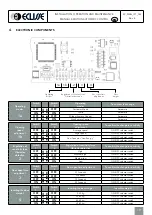
INSTALLATION, OPERATION AND MAINTENANCE
MANUAL E-MOTION AUTOMATIC CONTROL
EC_MAN_IST_022
Rev. 5
4
EN
1. 2 WARNINGS FOR CORRECT INSTALLATION OF THE AUTOMATION:
Verify that the ductwork for the passage of the conductors is carried out correctly; if it is possible
to prepare the wiring.
Ensure that the automation, the floor, the door guide and the surface of the underbody are level and
squared with the counter-frame.
Install the new track with the motorisation. Ensure that there are no obstacles and that the track is
correctly inserted.
Install the motorisation, taking care not to pinch cables.
To fit the track, remove the metal protection, “remove the plastic protection only if this is indispensable”
(this should always be refitted to prevent the circuits being accessible).
It is preferable to conduct the final test of the travel without the door panel, check the actual travel of the
carriage (if possible, test with a cardboard or light plywood template that simulates the size of the door
panel – not included).
Assemble the door panel, strictly complying with the instructions.
Once the door panel has been adjusted, be sure to tighten the carriage-bracket screws.
IMPORTANT: the door panel must always be positioned at least 10 mm from the floor.
The automation should be installed in such a way so that it can be inspected:
jambs, frames, fixtures etc.
must be removable;
- only some adjustments can be carried with the control installed
Attention:
- To carry out any repairs, the track must be removed.
Check that all accessories (door guide, jambs, frames, brushes, gaskets, brackets etc.) do not cause
friction.
Attention: in the maximum opening position, the door panel can stay at a gap of up to
50 mm
with
respect to the jambs due to the motor magnet spacing.
Ensure that the door is not subject to lateral compressions/depressions (due to blowers, suction units,
etc.); this could activate the obstacle interception device and be read as an error.
Check the automation with the panel and accessories assembled. The end user is not able to perceive the
force that is actually applied to move the door.
If necessary, carry out adjustments, always paying attention to the position of the trimmers or dipswitches
and any consequent variations for proper operation of the device.





































